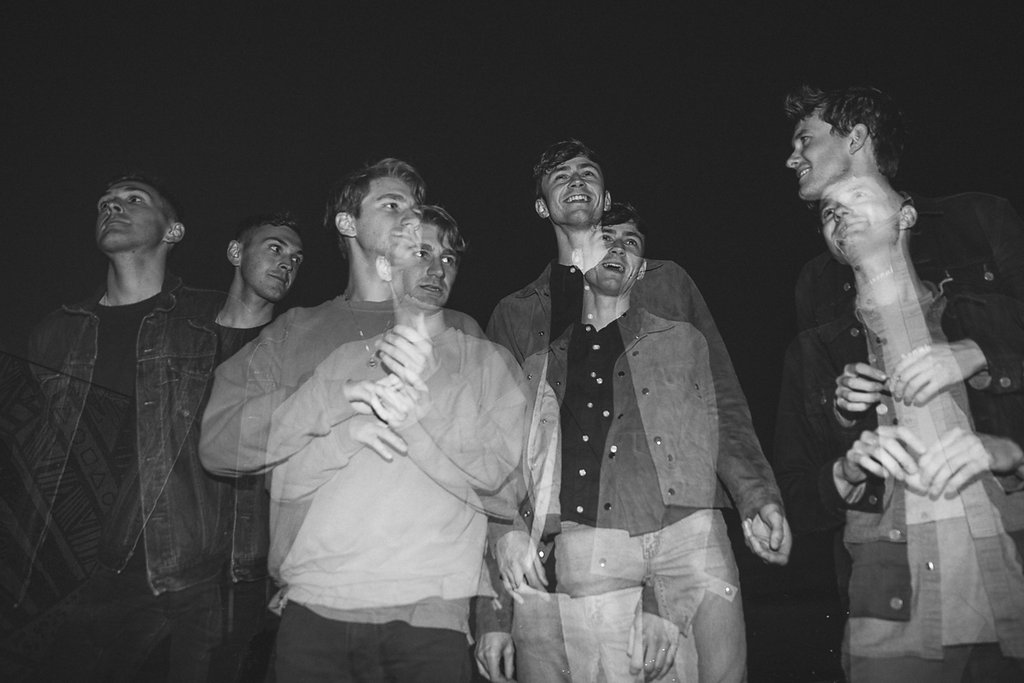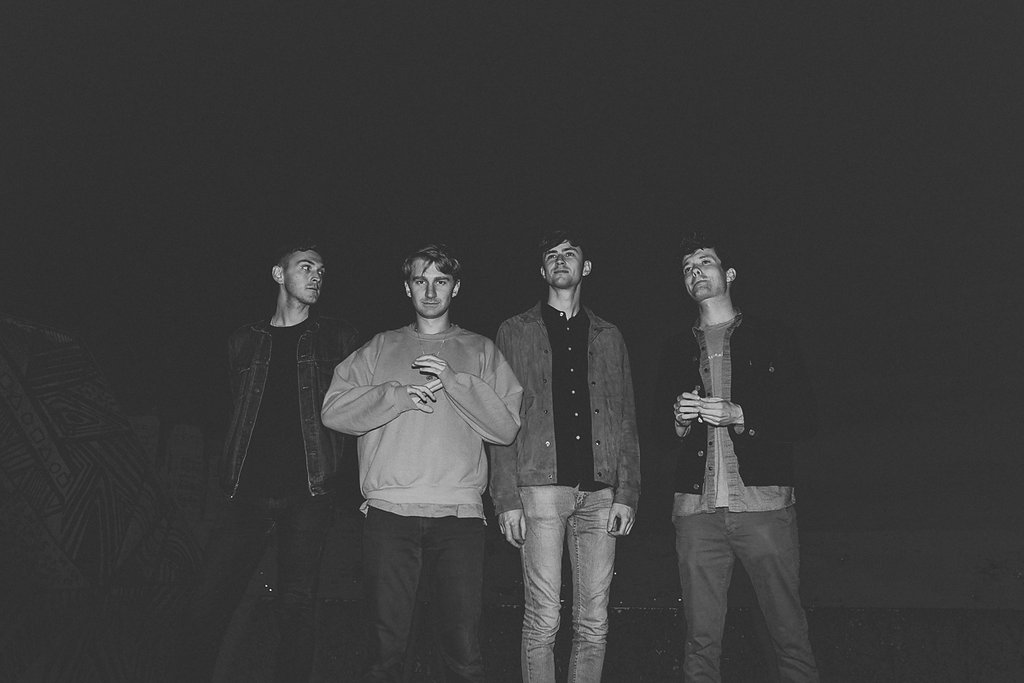Today sees the release of Glass Animals‘ highly anticipated sophomore record How To Be A Human Being. An intriguingly unique concept album, it marks an incredible second step for the band, whom we first met in 2014 with their debut album Zaba. Through its slinky, playfully onomatopoeic tracks like Gooey, Hazey and Pools, we were introduced to the Oxford based four-piece, and their identifiable, even signature sound – slinky, trip-hop infused beats that blend electronic production with live instrumentation. Their second album sees the band nurture and nourish that sound, building upon it with the confidence to explore and push, simultaneously introducing a complete set of stories, characters, settings and themes to each of its eleven tracks.
On a musical level, the new album is diverse, lush and surprising; much likes its predecessor, it’s an album as suited to the dance floor as it is the bedroom; equally fortuitous for the headphone listener and the party soundtracker. The band, with frontman and producer Dave Bayley in the director’s chair, has grown since Zaba. There’s more expression, more experimentation; they don’t so much as tiptoe beyond boundaries as leap above them. The result is a myriad beats and melodies that, despite remarkable distinction from one another, feel fluid and evenly spaced across forty-three minutes. On a thematic and lyrical level, there’s even more to absorb, making repeated listens both encouraged and beneficial. Each song is written from the perspective of a different person, as depicted on the album cover as well as the videos for first two singles Life Itself and Youth, also the first two tracks on the album.
Employing a refreshingly cool concept, How To Be A Human Being is essentially a collection of anecdotes. Each character has its own song, and its own story to tell. The band have toured extensively since the release of Zaba, and Bayley and band members Drew MacFarlane, Joe Seaward and Edmund Irwin-Singer found themselves caught up in more than a few strange new situations, meeting countless new and different human beings all over the world. These meetings laid the foundation and inspiration for many of these tracks – Bayley even recorded some of these conversations on his phone, which he claims began as a way to jog his self-confessed “terrible” memory.
Rather than directly creating songs about specific people, though, it was the thematic undercurrents of their stories and interactions that directed the album’s characters. “What I thought was interesting was the way people tell stories,” he says. “The way people express sadness, the themes that ran through all these stories that people tell a stranger. It was pretty weird.”
“People communicate in a weirdly optimistic way even though what they’re telling you might be really dark and heartbreaking, or very strange,” he says. “There’s a lightheartedness to the way people communicate, but it’s really significant, what they’re telling you. I just found that really amazing. A lot of it’s just a bit cheeky too. Quite fun, so you can hear these fun tales, but underneath it, there’s a much darker person.”

Curiouser still, is that the album is more than stories about people. They’re certainly not just stories about other people. “It’s a combination of autobiography and made up [stories], more than about any people that we met,” Bayley explains. “There were a lot of underlying themes that are in the record, and I was trying to recreate those undercurrents with new characters, and some autobiography, too.”
Weaving autobiographical elements into the narrative became an organic part of the project early on. “It just started happening. Funny things have happened to us, weird things happened to me and I’d think, that’d be cool to include in that character’s personality. So that happened naturally and that sort of fed into trying to write more personal songs – but I’m not gonna say which. I never thought [writing a personal record] would happen, but it makes it much easier to do on the record when the idea is that each song is this different characters. Each song has little bits of you in it, but it’s not entirely a record about yourself, which I think I would find incredibly boring to subject other people to.”
Zaba was a more abstract record, with many lyrics playing with sound more than story, and this is perhaps the biggest distinction between the two albums. How To Be A Human Being is grounded in reality, in humanity. As Bayley said, it is the closest he has come to writing a personal album, and he’s done so in fantastically sneaky manner. It’s a clever way to publicly explore and sing about one’s own life with truth and honesty, without actually pulling back the veil far enough for anyone to see who’s behind it. It also ties together the notion of what it actually means to be a human being; In spite of such divergent stories, perhaps we’re all more alike than we seem on the surface. Each character’s story may be radically distinct, but on a deeper layer they’re all connected.
The band were fascinated to discover that many of the strangers he met during a year on the road were so open and honest; as though that level of anonymity allowed strangers to be themselves. This isn’t a universal truth, in my experience, but a phenomenon often unique to the arts; you see a film, or you read a book, or you listen to an album that relates and has meaning to you. As such, you may feel close to its creator, almost like they’re your friend, or even a therapist, or a voice of authority and understanding. It’s best summarised in a quote I recently read in the graphic novel Daytripper. The protagonist, an author, has released his first novel, and it’s a smash hit. In the comic’s narratorial boxes, it reads: “It’s strange being famous. People think they know you…. [he] notices how many people greet him as if they’d already met him. They’ll skip all the preliminary questions strangers normally ask to break the ice. The book has done it already, it looked and smiled and won everybody over. The people who like the book naturally assume they’d like the author as welll. They think they know who he is. They think they’re his friends.”

This put the band in a strange new position where they were meeting hundreds of new faces, yet hearing stories that someone might not even tell their closest friends. As this continued to happen, the idea for an album of humans, of stories, came to be. Fourth track Pork Soda, for example, came from a tattoo. “It was a giant pig, a stick figure pig, a really cool pig,” Bayley says. “It said pork soda in big scrawling letters, I thought it was the best tattoo I’ve ever seen. It was this woman, she gave us a load of gifts, it was amazing, 30 little glass animals. I saw her tattoo, and I was like, ‘that’s sick – why?’ And she was like, ‘I just like pork soda,’ and I thought that was really cool, it played into the mentality of the person in that song. I just really liked the phrase.” And what exactly is pork soda? “It’s a drink. It’s a drink and it’s a meal, they put pork and cook it in coca cola in a stew. She says it’s the best meal and a drink.”
The more you listen – and the more you watch if you count the accompanying videos, which so far intertwine with one another and the overarching story – the more you learn, and the more layers you uncover. For the album to equally present both a range of colourful characters, and intimate layers of the band members themselves, ultimately presents the listener with a musical cross section of society today. And while this all may sound a little deep and philosophical, Bayley assures me that it’s still really playful and cheeky throughout – and indeed you can hear that irreverence throughout many of the album’s lyrics. “It’s meant to have weird layers, but I sound really pretentious if I start talking about it,” Bayley says. Speaking about the song Season 2 Episode 3 (with the track being the third song from their second album), he explains the cheek behind the title. “That song has ideas and layers to it but it’s just kinda cheeky. I wanted to do it “S02E03″ so it’s like, when you’re searching for the new Game of Thrones or something – I’m still on season 2, I’m catching up slowly. But it’s a nod toward the TV thing, this girl who spends her entire time watching TV, lounging around, not doing anything, being high, eating mayonnaise from a jar.”
The album itself came together almost entirely through putting down lyrics and chords first, with the production coming later. The one exception is Cane Shuga (a slang term for cocaine), which began the other way around. “That’s the only song that started as an actual beat,” Bayley says. “The production came first which was weird for this record. I’d had it lying around, been working on a series of beats and that one didn’t get used, Joe [Seaward, drummer] really liked it.” Seaward, sitting next to Bayley, grins smugly. “Yep, I’m responsible for that one.”
One of the only other anomalies on the album came by way of Seaward’s father, who contributed a flute layer to the track Mama’s Gun – “Back in the day, that was his thing,” he explains of his father. “He hadn’t done it for a while. He was really great though!” The band otherwise maintained a strict rule of only recording themselves, with no additional guests. “We broke the rule for that one song,” says Bayley. “It was a crisis to be fair – we don’t really live using samples but I really wanted to use this one sample. The context it provided as was interesting – I like using samples if they add more than just music.
“It’s a really weird Carpenters song called Mr Guder. The song is about a really odd character, and The Carpenters have an amazing history themselves – [Karen Carpenter] had terrible psychiatric problems, and that fed really nicely into the actual context of the song, Mama’s Gun. There are lots of little references to the words, and it all just fit, it just made sense. One of those things where you drop it in and it was too magical, because of what the song means and who wrote it, and it all works.
“The Carpenters let us use it, well, Mr Carpenter, but then their label wouldn’t let us put it in… So we had to replay it.”
The album may only be out today, but they’re already thinking about more. “We’ll be doing something soon, we get a bit itchy,” says Seaward. Their albums are a sacred Glass Animals-only space, but they’re open to working with others on different projects. Last year the band collaborated with rapper Joey Bada$$ for the track Lose Control, a collaboration which came about because, “We always like doing things with people who can only do stuff we can’t – we can’t rap so well, we can’t play the harp. We try working with people who can do amazing things that we’ll never be able to do. [Joey]’s one of them, he’s got an amazing sense of rhythm, it’s awesome watching him listen to music. He moves his head in a really amazing away. It’s weirdly how a lot of DJs hear music, they hear the backbeat, and Joey does that as well. A lot of rappers do the opposite, that was really cool.”
Glass Animals had already begun touring a few months before the album came out, including a short visit to Australia. Anyone who has seen Glass Animals live is no doubt familiar with the infectious energy they exude, and fans have a lot to look forward to, as a full new stage production is in the works. The biggest challenge for the band right now is perfecting the new songs live, as they’re so accustomed to performing from one album. “It’s fun to play new songs,” says Seaward. “It keeps us on our toes, we have to think – the possibility of stuff going wrong has increased exponentially, which makes us focused and engaged with each other, and it makes it slightly terrifying. By the end of the last touring cycle we’d played those songs so many times, so the chance of something going wrong was relatively high, but we knew how to deal with it if we did. Now, it’s terrifying.”
How To Be A Human Being is out now.
All images copyright Danielle Hansen / Howl & Echoes



